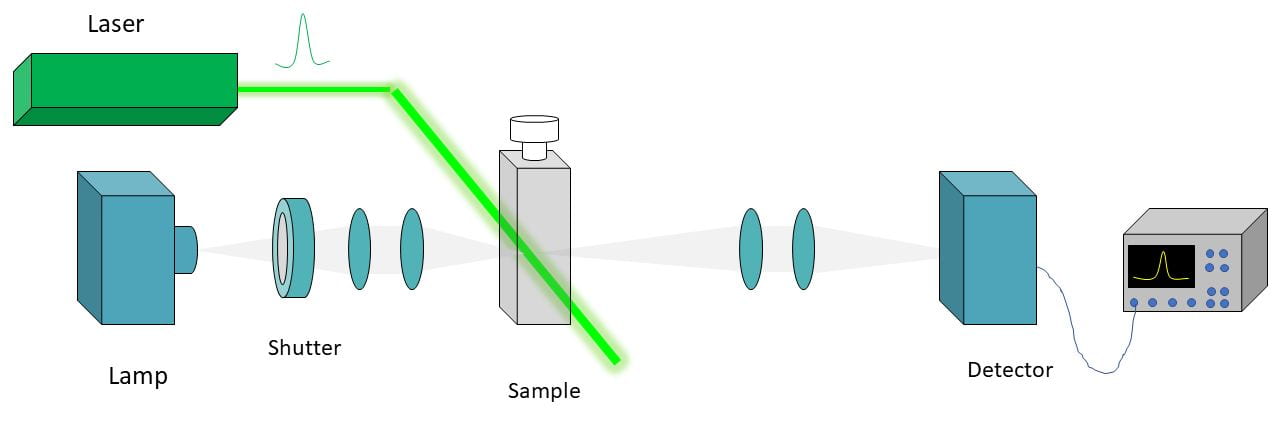Nanosecond gated spectroscopy
Laser flash photolysis
Laser flash photolysis spectroscopy is used to temporally characterise slow excited state chemical reactions, such as triplet recombination, phosphorescence, triplet-triplet annihilation, triplet-upconversion and thermally activated delayed fluorescence. This technique uses two synchronised pulses of light; a strong laser pump pulse with 5 ns pulse duration and a weak white-light probe pulse, typically 10 ms in duration. The pump pulse initiates a chemical reaction by generation of an excited chemical state. The change in absorption of the sample is recorded over time by temporal analysis of the transmitted probe pulse with a fast oscilloscope or gated CCD camera. Excited state dynamics of chemical reactions are obtained by monitoring the ground state recovery time and lifetime of photoinduced absorptions. The absorption measurements can be made over ns-ms timescales across both the visible and near-infrared spectral regions with 5 ns time resolution.1-4
Nanosecond emission spectroscopy
Nanosecond transient emission spectroscopy (ns-TES) is a used to time-resolve the emission of long-lived excited states with decay dynamics longer than 10 ns. It is often used to temporally characterise similarly slow excited state chemical reactions as described above, such as triplet recombination and slow excitonic/carrier recombination. The instrumentation is the same used for flash photolyisis measurements. Samples are excited with a broadly tuneable (225 – 2600 nm) 5 nanosecond pump pulse. The emission from the sample is collected and spectral analysed with a spectrometer. Single-wavelength kinetics can be recorded with a single-element detector (photomultiplier tube). Broadband spectra can also be detected with a 10-ns gated CCD camera.
- Gao, C.; Seow, J. Y.; Zhang, B.; Hall, C. R.; Tilley, A. J.; White, J. M.; Smith, T. A.; Wong, W. W. H., Tetraphenylethene 9,10-Diphenylanthracene Derivatives – Synthesis and Photophysical Properties. ChemPlusChem 2019, 84, 746-753.
- Gao, C.; Zhang, B.; Hall, C. R.; Li, L.; Chen, Y.; Zeng, Y.; Smith, T. A.; Wong, W. W. H., Triplet Fusion Upconversion Using Sterically Protected 9,10-Diphenylanthracene as the Emitter. Phys. Chem. Chem. Phys. 2020, 22, 6300-6307.
- Masoomi-Godarzi, S.; Hall, C. R.; Zhang, B.; Gregory, M. A.; White, J. M.; Wong, W. W. H.; Ghiggino, K. P.; Smith, T. A.; Jones, D. J., Competitive Triplet Formation and Recombination in Crystalline Films of Perylenediimide Derivatives: Implications for Singlet Fission. J. Phys. Chem. C. 2020.
- Masoomi-Godarzi, S.; Liu, M.; Tachibana, Y.; Goerigk, L.; Ghiggino, K. P.; Smith, T. A.; Jones, D. J., Solution-Processable, Solid State Donor–Acceptor Materials for Singlet Fission. Adv. Energy Mater. 2018, 8, 1801720.
